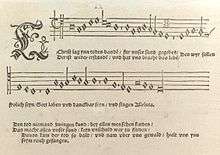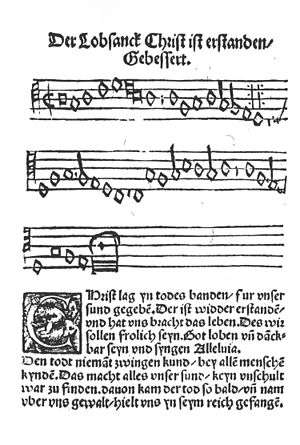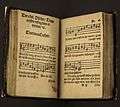Christ lag in Todesbanden
| "Christ lag in Todes Banden" | |
|---|---|
| Hymn by Martin Luther | |
 "Christ lag ynn todes bande" in Eyn geystlich Gesangk Buchleyn of 1524 | |
| English | Christ lay in death's bonds |
| Occasion | Easter |
| Language | German |
| Melody | by Luther and Johann Walter |
| Published | 1524 |
"Christ lag in Todesbanden" (also "... in Todes Banden"; "Christ lay in death's bonds") is an Easter hymn by Martin Luther. Its melody is by Luther and Johann Walter. Both the text and the melody were based on earlier examples. It was published in 1524 in the Erfurt Enchiridion and in Walter's choral hymnal Eyn geystlich Gesangk Buchleyn. Various composers, including Pachelbel, Bach and Telemann, have used the hymn in their compositions.
Text and melody
In early editions the hymn, in seven stanzas, was indicated as an improved (German: gebessert) version of "Christ ist erstanden".[1] The hymn is in bar form. The Stollen, that is the repeated first part of the melody, sets two lines of text for each repetition, with the remaining four lines of each stanza set to the remainder of the melody.
Text
The hymn celebrates the Resurrection of Jesus, with particular reference to a struggle between Life and Death. The third verse quotes from 1 Corinthians 15, saying that Christ's Atonement for sin has removed the "sting" of Death. The fifth verse compares the sacrifice with that celebrated by Jews in the Pascal Lamb at Passover. The sacrificial "blood" ("Its blood marks our doors") refers to the marking of the doors before the exodus from Egypt. The final stanza recalls the tradition of baking and eating Easter Bread, with the "old leaven" alluding again to the exodus, in contrast to the "Word of Grace", concluding "Christ would ... alone nourish the soul."
|
| |
|
| |
|
| |
|
| |
|
| |
|
| |
|
|
Melody

The melody as set by Luther seems to have strong correlations with parts of the Eucharistic sequence for Easter, Victimae paschali laudes,[2] believed to have been written by Wipo of Burgundy in the 11th century. This was transformed, gradually into a "Leise", a devotional German pre-Reformation song with a number of stanzas, but maintaining strong characteristics of plainsong. A new version was published in the Erfurt Enchiridion of 1524 and adapted the same years by Johann Walter in his choral hymnal Eyn geystlich Gesangk Buchleyn. This was subjected to many minor alterations in later hymnbooks, but the melodic shape remained the same in later additions, which include the addition of passing notes and modification of rhythmic patterns to conform the chorale to emerging styles, and to fit the chorale into a regular time signature.
Editions
In 1524 "Christ lag in Todesbanden" was published in the Erfurt Enchiridion and in Walter's choral hymnal Eyn geystlich Gesangk Buchleyn. The 1524 Erfurt Enchiridion presented the melody and text of Luther's hymn on two pages:


.jpg)
In 1545 the hymn appeared as No. 8 in the Babstsche Gesangbuch. In the Protestant hymnal Evangelisches Gesangbuch (EG) it appears in modernised language as EG 101.[3]
Use in other compositions
Bruhns, Böhm, Scheidt, Scheidemann, Pachelbel, Kuhnau and Telemann are among the composers who included the hymn in their work.[2][4] As one of the principal Lutheran hymns for Easter, it appears in several vocal and organ compositions of Johann Sebastian Bach:[1]
- Christ lag in Todes Banden, BWV 4, an early chorale cantata for Easter, opens with a sinfonia, followed by seven movements, using each of the original seven verses by Luther, and with the melody as a cantus firmus.
- The cantata Der Friede sei mit dir, BWV 158, uses the fifth verse of Martin Luther's chorale in a four-part chorale in the fourth and final movement.
- Christ lag in Todesbanden, BWV 277, 278 and 279 are included in Bach's four-part chorale settings.
- Christ lag in Todesbanden, BWV 625, is a chorale prelude from the Orgelbüchlein of only 16 bars in length (excluding repeats). Harmonically it closely follows the four parts of the chorale BWV 278 with the chorale melody in the soprano voice virtually unchanged.[2][5]
- Fantasia super Christ lag in Todes Banden, BWV 695, is a chorale prelude from the Kirnberger chorale preludes (BWV 690–713), consisting of a two-part fughetta above the chorale melody in the bass [6]
- Christ lag in Todes Banden, BWV 718, is chorale prelude, which uses the chorale tune as a cantus firmus through a range of textures, alternating between triplet and semiquaver movement.[7]
References
- 1 2 3 Terry (1921), pp. 115–120
- 1 2 3 Williams (2003), pp. 284–286
- ↑ Marti (2005)
- ↑ bach-cantatas.com (2010)
- ↑ Renwick (1995)
- ↑ Williams (2003), p. 434
- ↑ Williams (2003), pp. 470–471
Sources
- "Chorale Melodies used in Bach's Vocal Works: Christ lag in Todesbanden". bach-cantatas.com. Retrieved 13 September 2010.
- Marti, Andreas (2005). "101 – Christ lag in Todesbanden", pp 56–62 in Liederkunde zum Evangelischen Gesangbuch Volume I No. 12, edited by Gerhard Hahn and Jürgen Henkys (in German). Göttingen: Vandenhoeck & Ruprecht. ISBN 3-525-50335-0
- Renwick, William (1995), Analyzing Fugue: A Schenkerian Approach, Pendragon Press, pp. 4–6, ISBN 0945193521
- Terry, Charles Sanford (1921), Bach's Chorals, vol. III
- Williams, Peter (2003), The Organ Music of J. S. Bach (2nd ed.), Cambridge University Press, ISBN 0-521-89115-9
External links
| Wikimedia Commons has media related to Christ lag in Todesbanden. |
 German Wikisource has original text related to this article: Christ lag yn todes banden
German Wikisource has original text related to this article: Christ lag yn todes banden- ""Christ lag in Todesbanden", text and translation". bach-cantatas.com. 2005. Retrieved 13 August 2010.
